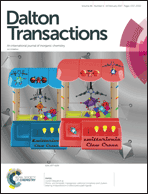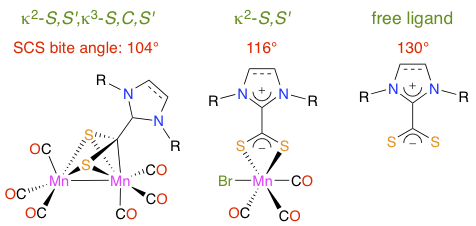"Mono- and Bimetallic Manganese-Carbonyl Complexes and Clusters Bearing Imidazol(in)ium-2-dithiocarboxylate Ligands"
Tomás F. Beltrán, Guillermo Zaragoza, and Lionel Delaude
 |
source: Dalton Transactions
year: 2017
volume: 46
first page: 1779
last page: 1788
doi: 10.1039/c6dt04780g
|

Abstract: Five complexes with the generic formula fac-[MnBr(CO)3(S2C·NHC)] were obtained by reacting [MnBr(CO)5] with a set of representative imidazol(in)ium-2-dithiocarboxylate zwitterions. These ligands are the adducts of N-heterocyclic carbenes (NHCs) and carbon disulfide. The mononuclear Mn(I) derivatives were coupled with Na[Mn(CO)5] to afford bimetallic [Mn2(CO)6(S2C·NHC)] clusters. Yet, the most convenient strategy to access these dinuclear Mn(0) products implied a direct carbonyl substitution from the [Mn2(CO)10] dimer. The molecular structures of three monometallic and four bimetallic compounds were elucidated by single crystal X-ray diffraction analysis. In the monometallic complexes, the NHC·CS2 ligands exhibited a bidentate κ1-S,S' coordination mode with an S-C-S bite angle of about 116°. In the dinuclear clusters, the CS2- unit acted as a chelate toward one manganese center and as a pseudoallylic ligand toward the other one. The S-C-S bite angle was reduced to ca. 104°. Thus, the zwitterions displayed a remarkable flexibility, which also permitted a staggered arrangement of the carbonyl groups in the bimetallic systems. Examination of the νCO absorption bands on IR spectroscopy helped identify the presence of fac-Mn(CO)3 or Mn2(CO)6 motifs, while the 13C NMR chemical shift of the CS2- moiety was a reliable indicator for monitoring its hapticity. Whereas the dinuclear clusters were air- and moisture-stable crystalline solids, mononuclear halido derivatives displayed only a limited stability under aerobic conditions. Both types of compounds underwent rather unselective, extensive fragmentations in the gas phase, in sharp contrast with the analogous rhenium derivatives that led to clean sequential decarbonylation processes upon collision-induced dissociation.
[Full Text] [<< Previous Article] [Back to the List of Publications] [Next Article >>] l.delaude@ulg.ac.be